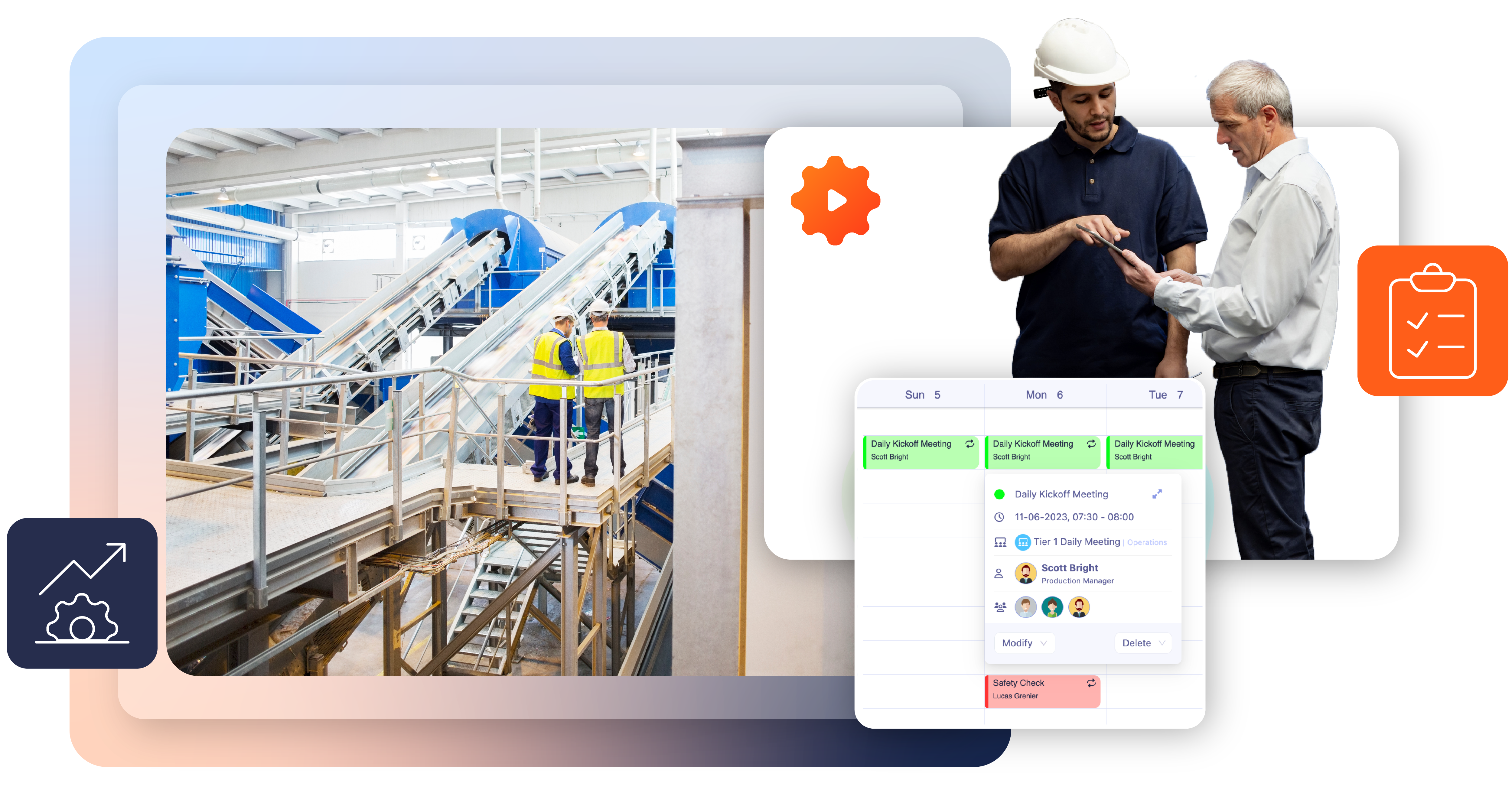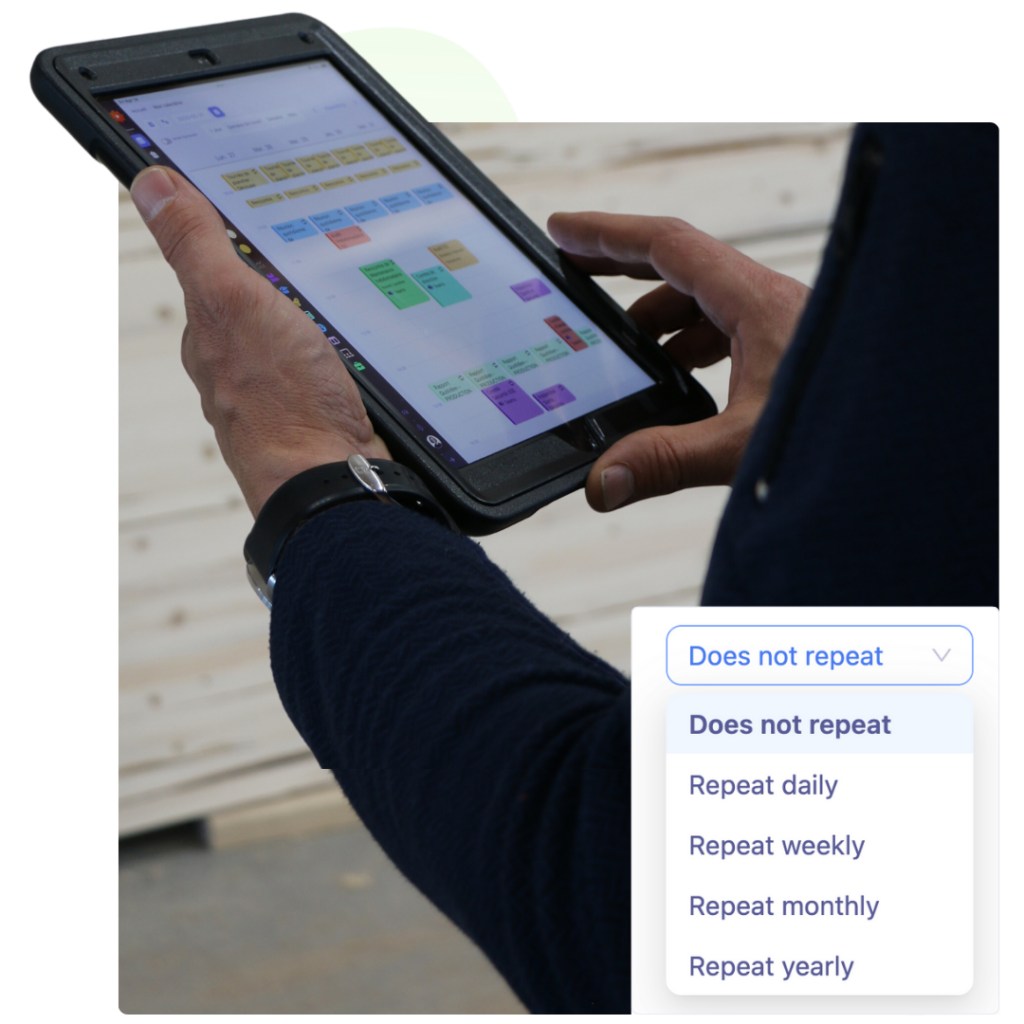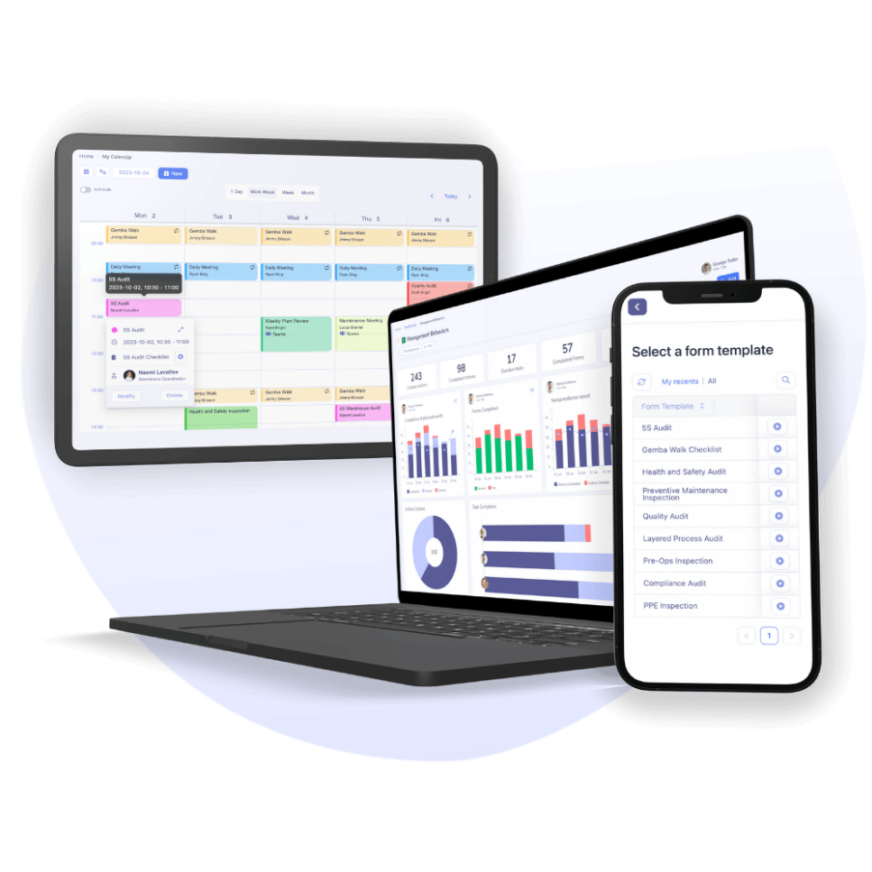Leader Standard Work (LSW) Blueprint for All Management Levels

| Audience: | Manufacturing Managers, Healthcare Administrators, Operational Excellence and Lean Management Practitioners, HR Coordinators, Organizational Leaders |
| Last updated: | December 12, 2025 |
| Read time: | 13 min |
- Fundamental Components: Gemba Walks, recurring meetings, strategic planning, communication cascade, and monitoring performance indicators.
- Implementation: Standardizes leadership activities across all levels, from frontline supervisors to executives.
- Benefits: Reduces variations in management practices. Enhances problem-solving and accountability. Establishes operational control. Fosters continuous improvement.
Managers bring plenty of technical knowledge to the table, but without structure in place, their talent risks being wasted. For example, they might put essential leadership activities on the back burner in favour of tackling issues on the production floor.
Undoubtedly, mastering hard skills doesn’t necessarily translate into possessing soft skills. Not to mention that senior and newly promoted supervisors will certainly adopt different behaviours. This situation is quite challenging for organizations facing workforce turnover and labour shortages.
Typically, organizations standardize their employees’ work and daily activities through schedules, operating procedures, and performance management systems. But senior and newly promoted supervisors often choose to implement their own SOPs, and organizations dealing with turnover and staff shortages can quickly begin drowning in process variation.
So, how can you standardize management across different shifts and sites? This article provides detailed answers to these questions.
What is the meaning of Leader Standard Work (LSW)
Leader Standard Work (LSW) is a set of routines, processes, and tasks that guide managers towards consistent and efficient performance on a daily, weekly, and monthly basis.
Its core purpose is to incorporate structured actions and tools into leadership practices to problem-solve faster, collaborate smarter, and keep everyone on the same page.
These routines, skills, and tasks can include collaborative efforts in recurring meetings (stand-ups or daily huddles) and observational methods like floor tours (Gemba Walks).
By establishing these actions as part of leaders’ daily work, LSW works to reduce variation in management practices while enabling continuous process improvement.
Watch this Leader Standard Work video
Industrial leaders leverage Tervene to digitalize LSW checklists and routines

Leader Standard Work (LSW) components
- Routines: Standardizing daily, weekly, and monthly workflows
- Skills: Developing leadership aptitudes and establishing priorities
- Tools: Equipping leaders to navigate their routines successfully
- Accountability: Creating accountability for performance targets
Leader Standard Work is the basis for consistent, high-quality leadership. By defining clear expectations and aligning leaders’ actions with organizational goals, LSW reduces variability, strengthens accountability, and supports continuous improvement across all levels of management.
Standardization
Leader Standard Work provides a framework for how team leaders, supervisors, and managers should execute daily, weekly, and monthly tasks. Standardization often relies on clearly defined checklists to ensure consistency across teams and shifts.
Example: In manufacturing, implementing LSW involves standardizing equipment care checklists. Maintenance teams know precisely when and how to conduct inspections, and how to escalate any issues they encounter along the way.
Leadership
LSW enables leaders at every level to prioritize the right objectives while actively supporting their teams. It also boosts performance by equipping them with operational routines, checklists, and structured leadership tasks.
Example: Healthcare facilities use LSW to train senior personnel in coaching junior doctors, nurses, and administrators, fast-tracking onboarding and enhancing skill development.
Proactive management
Proactive tasks like planning, coaching, and team support are the antidote to the reactive “firefighting” mode. These processes guide managers in identifying issues and nonconformities, capturing data, and logging ideas for improvement before a disaster strikes.
Example: Within a production line, leaders dedicate time to actively supporting assembly line workers. By conducting daily Gemba Walks and providing real-time guidance on process improvements, managers can optimize performance and encourage continuous skill development among their teams.
Continuous improvement and problem-solving
LSW cultivates a culture of continuous improvement and problem-solving by implementing structured management routines. It establishes clear communication cascades and regular check-ins to increase collaboration and accelerate resolutions.
Example: LSW in a project management setting involves regular cross-functional team meetings to address project challenges. This practice encourages team members to solve problems collectively.

How to implement LSW
Successfully rolling out LSW means tailoring it to each leadership tier’s responsibilities and influence. The core principles stay the same, but the balance between hands-on oversight, strategic planning, and coaching changes as you move from the shop floor to the executive suite.

10 Steps to implement Leader Standard Work in 4 weeks
Leader Standard Work (LSW) for different levels
- Team Leader focus: Standardizing tasks like shift handovers, problem-solving methods, and daily routines. Team leaders spend about 80% of their time on standardized activities such as process confirmation and coaching.
- Middle Management focus: Standardizing meeting structures, reporting mechanisms, and ensuring adherence to established procedures. Around 50% of middle management’s time is allocated to structured activities and reviews.
- C-Level Executive focus: Establishing consistent goal-setting processes and site visits. Executives allocate approximately 10% of their time to overseeing strategy, ensuring compliance with established standards and focusing on long-term organizational objectives.

How to standardize leaders’ work
1. Create structured management practices
LSW is intended to establish daily control, supervise activities, escalate issues, and improve communication between teams. It also formalizes how managers detect problems and follow up on corrective actions.
Daily checks (proactive Gemba Walks)
- Process confirmation
- Team leader Gemba Walk
- Executive Gemba Walk
- 5S checklist
- Safety walk
Audits and recurrent inspections
- HACCP, ISO, SQF audit
- Health and safety inspection
- Equipment inspection
- Standard operating audit
- 5S audit
Visual management
- Monitoring KPI dashboards
- Monitoring supervisor performance
- 5S system
Procedures and training
- Troubleshooting
- Operational procedures
- Setup (SMED)
- Employee evaluation
- Best practices
- Preventive maintenance
- Employee onboarding
- Training programs
2. Equip team leaders and directors with management tools
It’s nearly impossible to maintain high management standards with decentralized tools such as SMS, email, paper-based inspections, whiteboards, sticky notes, and Excel. Over time, the need to transcribe, chase down, and locate information makes it impossible to work efficiently.
A digital daily management system increases supervisors’ adherence to management processes through structure and accountability. For example, read about how Kruger Products went digital to manage their day-to-day operations.
3. Establish daily, weekly, and monthly routines
An LSW Calendar is instrumental in defining managers’ recurring responsibilities, including regular inspections, audits, floor tours, and daily meetings. As a part of Leader Standard Work, this calendar serves as a framework that defines management rituals and enables top-level leaders to monitor adherence levels, ensuring consistency and efficacy across the organization.

4. Establish objectives and performance indicators
KPIs streamline the tracking of departmental objectives by establishing clear goals, facilitating effective monitoring through quantifiable performance metrics, and promoting a sense of ownership and accountability, thereby improving decision-making and resource allocation.
5. Promote optimal management behaviours
Setting the standard for good management is how organizations boost their entire team’s performance. Recurrent 1:1 meetings facilitate objective discussions and prevent stagnation, while regularly refining standardized work ensures the whole operation runs efficiently. All of this should be underpinned by structured coaching to help leaders understand their LSW objectives, develop their skills, and maintain accountability.
Personal development enables continual improvement, while initiatives like embracing letdowns for accelerated learning, skill enhancement, and promoting positive behaviour contribute to leadership growth.
Relevant Tervene tools
What is the difference between standard work and leader standard work?
Standard work focuses on operators’ and frontline employees’ procedures, such as detailed SOPs and 5S principles. LSW structures leaders’ schedule and guides their managerial behaviours.
This distinction allows standardization at all organizational levels:
- Operators: Schedule, work instructions, SOPs, proactive validation from supervisors, and 5S at workstations.
- Team Leaders and Supervisors: Inspections, Gemba Walk structure, daily meetings, and supervision routine.
- Support Groups: Problem-solving process, issue escalation, and corrective actions.
- Managers and Directors: Department standardization, management committees.
- VP: Strategic alignment, corporate objectives, site standardization.
Pro tip: If your organization also uses an FMDS (Floor Management Development System), you can align its routines with LSW to create a consistent leadership cadence from the shop floor to the executive level.
Comparison chart
| Focus | Specific task execution for efficiency and quality | Less precise, focusing on adaptable leadership actions and behaviours |
| Activities | Following detailed procedures (SOPs), schedules, 5S principles, and meeting performance targets | Gemba Walks, strategic direction setting, coaching, mentoring, problem-solving, supporting teams |
| Standardization | High level of standardization in daily tasks | Conducting Gemba Walks, coaching team members, leading problem-solving sessions, and setting goals |
| Impact | Directly impacts production efficiency, quality, and output | Indirectly impacts performance by nurturing a culture of continuous improvement |
| Examples | Assembling a product, operating a machine, following a maintenance checklist | Conducting Gemba Walks, coaching team members, leading problem-solving sessions, setting goals |
Example of Leader Standard Work
Sarah, a newly promoted supervisor, sticks to a well-planned agenda for her first day of operations management on the manufacturing floor.
Her morning routine begins with a proactive Gemba Walk to collect real-time operational insights. Then, she leads a quick production meeting to ensure the team is aligned and well-equipped to address immediate concerns.
In the afternoon, Sarah executes a second Gemba Walk and facilitates a seamless shift handover meeting to maintain operational continuity. Later that week, she dedicates time to a health and safety inspection and conducts a comprehensive 5S audit to uphold organizational standards.
For more LSW examples, visit our template hub, where you can explore a variety of structured daily work agendas tailored to different managerial roles.

What are the benefits of leader standard work?
When managers work together within a set framework, the effects are felt throughout the entire organization. As a result, there are plenty of proven benefits associated with Leader Standard Work, including:
Aligning with organizational goals
Establishing standard practices aligned with your organization’s objectives ensures that managerial efforts directly support the company’s overarching goals.
Cultivating problem-solving skills
LSW empowers leaders to leverage coaching as a catalyst for developing problem-solving skills within their teams.
Proactively controlling operations
System standardization provides managers with a framework for detecting and resolving issues before they are caught off guard.
Streamlining employee onboarding and workplace safety
Implementing LSW streamlines operations, accelerates employee onboarding, and promotes a safer workplace environment.
Engaging in continuous improvement
LSW engages entire teams, from the bottom up, in ongoing process-driven problem-solving efforts. It also fosters a blame-free environment by shifting the focus from individuals to systemic improvements.
Enhancing response agility
By prioritizing process-based problem-solving over individual attributions, LSW cultivates enhanced response agility, eradicates silos, and instills a culture of accountability.
Free LSW template and checklist for manufacturing
Not ready to go digital? We’ve prepared a free Leader Standard Work template and checklist to help you start standardizing management practices immediately. This resource includes structured daily, weekly, and monthly routines, along with proven Gemba Walk steps, meeting guidelines, and performance tracking ideas you can adapt to your own operations.
Download free LSW templates and checklists

8 customizable calendar templates for daily, weekly, and monthly schedules
Connecting LSW and DMS
Leader Standard Work and Daily Management Systems share a profound connection: both work to shape an organization’s culture and drive continuous improvement.
Foundation of lean leadership routines and culture
As a set of structured routines that guide managerial tasks, LSW creates a foundation for consistent leadership. Integrated seamlessly into a DMS, LSW encompasses essential practices such as daily accountability processes, Gemba Walks, and process confirmation.
This approach is closely related to Lean Daily Management (LDM), which combines these routines with visual boards and daily performance tracking to strengthen team alignment.
Catalyst for accountability and alignment
Both LSW and DMS reinforce accountability within an organizational framework. LSW’s emphasis on setting standards and enabling continuous improvement aligns seamlessly with the DMS’s accountability-driven nature. Additionally, both systems ensure leaders’ engagement in activities that align with organizational strategies.
Enabling leadership traits through LSW and DMS
LSW shapes leadership behaviours by promoting practices such as Gemba Walks and structured tiered meetings. Furthermore, both systems aim to foster a culture of operational excellence, aligning efforts toward continuous improvement and problem-solving.
In essence, Leader Standard Work acts as the guiding principle, setting expectations and behaviours for leaders. At the same time, the Daily Management System provides the structure and processes for leaders to enact and sustain those behaviours.
What is Leader Standard Work in Kaizen, and how is it used in Lean?
At its core, LSW fits perfectly within the Kaizen (Lean Management) framework.
Lean focuses on creating value for the customer and eliminating waste. LSW ensures leaders focus on the right priorities: coaching teams, reviewing processes, and solving problems before they escalate. It helps you live Lean, not just talk about it.
LSW naturally aligns with key Lean principles:
- Respect for people: You show respect by being present, listening, and supporting continuous improvement.
- Continuous improvement: LSW builds regular reflection and problem-solving into your routine.
- Standardization: It establishes a precise rhythm for leadership behaviours, enabling improvement to be repeatable and sustainable.
You’ll also see LSW reinforce classic Lean tools:
- The PDCA cycle (Plan-Do-Check-Act) becomes part of every leader’s day.
- Visual management becomes more effective because leaders review performance visually and in real time.
- Kaizen thrives when leaders model minor, daily improvements.
Here’s a simple example: In a manufacturing plant, introducing LSW helped supervisors start daily gemba walks and five-minute team huddles. Within months, communication improved, problems surfaced faster, and departments began sharing best practices.
The result? A more connected, mature Lean culture that kept improving, together.
How is Leader Standard Work applied in Six Sigma?
In Six Sigma, Leader Standard Work keeps improvement consistent and visible. \
Leaders use it to schedule time for data reviews, process checks, and coaching on problem-solving tools like DMAIC. It ensures they don’t just react to issues, but proactively sustain improvements.
By standardizing leadership routines, LSW helps Six Sigma projects stay disciplined, measurable, and continuously improving.
How to coach leaders to follow LSW effectively
Even the best structure fails if people don’t use it. Leader Standard Work only works when leaders truly live it. Coaching helps make that happen.
Start by keeping it human. Managers should coach supervisors and team leads to view LSW as a tool for focus, rather than control. Encourage them to treat routines like habits, built through small, consistent actions.
A great way to reinforce these habits is through short daily reflections or end-of-week reviews. Ask a simple set of questions like:
- What worked well this week?
- What did you learn from your walks or check-ins?
- What will you adjust next week?
These quick moments help leaders stay mindful and keep improving.
Accountability is key, but skip the micromanagement. Instead, use light-touch tools like visual boards, brief check-ins, or shared dashboards. Everyone can see progress and stay aligned without feeling pressured.
Here’s a practical tip: pair new leaders with LSW “buddies.” A buddy can model routines, share lessons, and offer support when things get busy.
Coaching LSW isn’t about enforcing compliance. It’s about helping leaders build confidence, consistency, and a rhythm that drives real improvement, every day.
How to measure success while creating Leader Standard Work
If you don’t measure it, you can’t improve it. The same goes for Leader Standard Work. Tracking how well leaders follow and benefit from LSW turns routines into tangible results.
Start by focusing on practical, visible metrics. You want measures that show both consistency and impact (not just paperwork). Here are a few key indicators:
- Adherence rate: How often leaders complete their standard routines.
- Issue resolution speed: How quickly problems found during Gemba walks get solved.
- Engagement in Gemba walks: Frequency and quality of leader presence on the floor.
- Audit pass rate: Results from LSW reviews or process audits.
But metrics alone aren’t enough. Link them to broader business outcomes, such as safety, quality, and productivity. For example, consistent LSW often leads to fewer safety incidents or faster problem-solving on the line. That’s how you show its real value.
Here’s a simple LSW scorecard example you can use or adapt:
| Metric | How to Calculate | Good Benchmark |
| Adherence Rate | (Completed LSW tasks ÷ Planned tasks) × 100 | 90%+ |
| Issue Resolution Speed | Average hours/days to close issues | < 3 days |
| Gemba Walk Participation | Gemba walks done ÷ scheduled walks | 95%+ |
| Audit Pass Rate | Audits passed ÷ audits completed | 90%+ |
| Team Engagement | % of team feedback sessions completed | 85%+ |
Use this scorecard in weekly reviews or dashboards. You’ll see where leaders shine and where extra coaching helps. Over time, those numbers tell a powerful story of Lean maturity in action.
How technology can help uphold management standards
Digital solutions streamline LSW by providing centralized documentation, real-time updates, collaboration tools, and robust data analysis capabilities. They alleviate administrative burdens associated with analog operations, such as transcription and follow-ups, and enable data analysis at a scale that would otherwise be impossible.
These LSW tools streamline Leader Standard Work with features such as:
- Automated scheduling: Effortlessly schedule and assign tasks based on customizable templates and priority levels.
- Real-time progress tracking: Visualize task progress, identify bottlenecks, and proactively address potential delays.
- Clear accountability: Assign task ownership, track individual contributions, and foster a culture of accountability.
- Activity analysis and improvement: Systematically evaluate activities, identify areas for improvement, and eliminate wasteful practices.
- Digital Gemba Walk notes: Capture observations, photos, and insights directly within the platform for data-driven decision-making.
Accelerate your LSW program with our software
Tervene makes it easy to implement a successful LSW program
- Standardize your management activities at scale
- Empower high-performing managers and supervisors
- Ensure accountability and effective leadership

FAQ: Leader Standard Work
Leader Standard Work builds consistency, visibility, and accountability. It helps leaders focus on what matters: coaching teams, solving problems early, and driving continuous improvement across the organization.
In Kaizen, Leader Standard Work ensures improvement is continuous, not occasional. It guides leaders to create daily habits (observing, supporting, and improving processes), so small gains add up to lasting change.
Standard Work defines how frontline tasks are done. Leader Standard Work defines how leaders support, monitor, and improve those tasks: creating a system where improvement becomes everyone’s daily job.
Start simple. Define the leader’s key responsibilities, schedule them into daily routines, and adjust over time. Involve the team to make sure the routines add real value.
Introduce it gradually. Begin with a pilot, use visual tools or checklists, and coach leaders to make it part of their rhythm. Review and refine regularly.
It often looks like a structured checklist or calendar (listing routine tasks like Gemba walks, team meetings, and reviews) to help leaders stay consistent and focused on improvement.
It’s a simple document outlining a leader’s recurring tasks, timing, and purpose. Templates help maintain consistency and make routines easier to track, share, and improve.
It brings structure to leadership. Creating consistent habits keeps Lean systems alive, empowers teams, and ensures improvement happens daily rather than just during special projects.
Follow us on LinkedIn






























